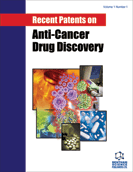
Abstract
Background and Purpose: A number of recent patents related to 125I seed and osteopontin have been awarded. In this study, we developed a new in vitro model to study the radiobiological effects of 125I seeds on cancer cells. Methods: We placed 125I seeds in a cell culture plate with cells seeded on a transwell chamber to evaluate the effects of 125I seeds on cell motility. We placed 125I seeds in a transwell chamber with cells seeded on the cell culture plate to study cell proliferation, apoptosis, and to perform western blot. Results: We used SK-Hep-1 liver cancer cells to evaluate the effectiveness of our model, and investigated the role of osteopontin in the therapeutic effects of 125I seeds. We found that 125I seeds inhibited the cell proliferation and motility in this model while osteopontin reduced these effects. We also measured the effects of 125I seeds on apoptosis. Furthermore, when treated with 125I seeds, we detected changes in several signaling pathways that are involved in the proliferation and invasion of cancer cells. Conclusions: The model can be used to assess the biological effects of 125I seeds in vitro. Osteopontin may be involved in the 125I seed-induced inhibition of SK-Hep-1 cells.
Keywords: Cancer cells, 125I seeds, liver cancer cells, model, osteopontin, transwell insert.
Recent Patents on Anti-Cancer Drug Discovery
Title:Cell-Based Assay System to Estimate the Effect of 125I Seeds on Cancer Cells: Effect of Osteopontin
Volume: 9 Issue: 2
Author(s): Guang Yang, Sheng Peng, Yanling Zhang, Zhenyin Liu, Mingjian Lu, Tao Zhang, Fei Gao and Fujun Zhang
Affiliation:
Keywords: Cancer cells, 125I seeds, liver cancer cells, model, osteopontin, transwell insert.
Abstract: Background and Purpose: A number of recent patents related to 125I seed and osteopontin have been awarded. In this study, we developed a new in vitro model to study the radiobiological effects of 125I seeds on cancer cells. Methods: We placed 125I seeds in a cell culture plate with cells seeded on a transwell chamber to evaluate the effects of 125I seeds on cell motility. We placed 125I seeds in a transwell chamber with cells seeded on the cell culture plate to study cell proliferation, apoptosis, and to perform western blot. Results: We used SK-Hep-1 liver cancer cells to evaluate the effectiveness of our model, and investigated the role of osteopontin in the therapeutic effects of 125I seeds. We found that 125I seeds inhibited the cell proliferation and motility in this model while osteopontin reduced these effects. We also measured the effects of 125I seeds on apoptosis. Furthermore, when treated with 125I seeds, we detected changes in several signaling pathways that are involved in the proliferation and invasion of cancer cells. Conclusions: The model can be used to assess the biological effects of 125I seeds in vitro. Osteopontin may be involved in the 125I seed-induced inhibition of SK-Hep-1 cells.
Export Options
About this article
Cite this article as:
Yang Guang, Peng Sheng, Zhang Yanling, Liu Zhenyin, Lu Mingjian, Zhang Tao, Gao Fei and Zhang Fujun, Cell-Based Assay System to Estimate the Effect of 125I Seeds on Cancer Cells: Effect of Osteopontin, Recent Patents on Anti-Cancer Drug Discovery 2014; 9 (2) . https://dx.doi.org/10.2174/1574892809666140331151747
| DOI https://dx.doi.org/10.2174/1574892809666140331151747 |
Print ISSN 1574-8928 |
| Publisher Name Bentham Science Publisher |
Online ISSN 2212-3970 |
 68
68
- Author Guidelines
- Graphical Abstracts
- Fabricating and Stating False Information
- Research Misconduct
- Post Publication Discussions and Corrections
- Publishing Ethics and Rectitude
- Increase Visibility of Your Article
- Archiving Policies
- Peer Review Workflow
- Order Your Article Before Print
- Promote Your Article
- Manuscript Transfer Facility
- Editorial Policies
- Allegations from Whistleblowers
Related Articles
-
Novel 1,2,3-Triazole-functionalized pyrido[3',2':4,5]furo[3,2-d]pyrimidin- 4(3H)-one Derivatives: Synthesis, Anticancer Activity, CoMFA and CoMSIA Studies
Letters in Organic Chemistry The Crosstalk Between the Matrix Metalloprotease System and the Chemokine Network in Acute Myeloid Leukemia
Current Medicinal Chemistry Keeping the Balance Between Proliferation and Differentiation:The Primary Cilium
Current Genomics IMPDH2 Positively Impacts the Proliferation Potential of Hepatoblastoma Cells by Activating JunB Signaling Pathway
Current Molecular Pharmacology New Insights in Drug-Induced Mitochondrial Toxicity
Current Pharmaceutical Design A Structural Insight into Hydroxamic Acid Based Histone Deacetylase Inhibitors for the Presence of Anticancer Activity
Current Medicinal Chemistry Application of Electroporation in DNA Vaccination Protocols
Current Gene Therapy Manganese Superoxide Dismutase (Sod2) and Redox-Control of Signaling Events That Drive Metastasis
Anti-Cancer Agents in Medicinal Chemistry Ent-11α-Hydroxy-15-Oxo-Kaur-16-en-19-Oic-Acid Induces Apoptosis of Human Malignant Cancer Cells
Current Drug Targets DNA Damage-inducing Compounds: Unraveling their Pleiotropic Effects Using High Throughput Sequencing
Current Medicinal Chemistry Stress Hormone-Mediated DNA Damage Response -- Implications for Cellular Senescence and Tumour Progression
Current Drug Targets Cancer T Cell Immunotherapy with Bispecific Antibodies and Chimeric Antigen Receptors
Recent Patents on Anti-Cancer Drug Discovery Bioconversion of Isoflavones into Bioactive Equol: State of the Art
Recent Patents on Food, Nutrition & Agriculture Genome-wide Analysis of Myelodysplastic Syndromes
Current Pharmaceutical Design Radiopharmaceutical Tracking of Particles Injected into Tumors: A Model to Study Clearance Kinetics
Current Drug Delivery Royal Jelly Acid, 10-Hydroxy-trans-2-Decenoic Acid, as a Modulator of the Innate Immune Responses
Endocrine, Metabolic & Immune Disorders - Drug Targets Imaging Cellular Receptors in Breast Cancers: An Overview
Current Pharmaceutical Biotechnology Targeting Kinases in Cancer Therapies: Adverse Effects on Blood Platelets
Current Pharmaceutical Design Readjusting the Glucocorticoid Balance: An Opportunity for Modulators of 11β -Hydroxysteroid Dehydrogenase Type 1 Activity?
Endocrine, Metabolic & Immune Disorders - Drug Targets Toll-Like Receptor (TLR) Response Tolerance: A Key Physiological “ Damage Limitation ” Effect and an Important Potential Opportunity for Therapy
Current Medicinal Chemistry


























